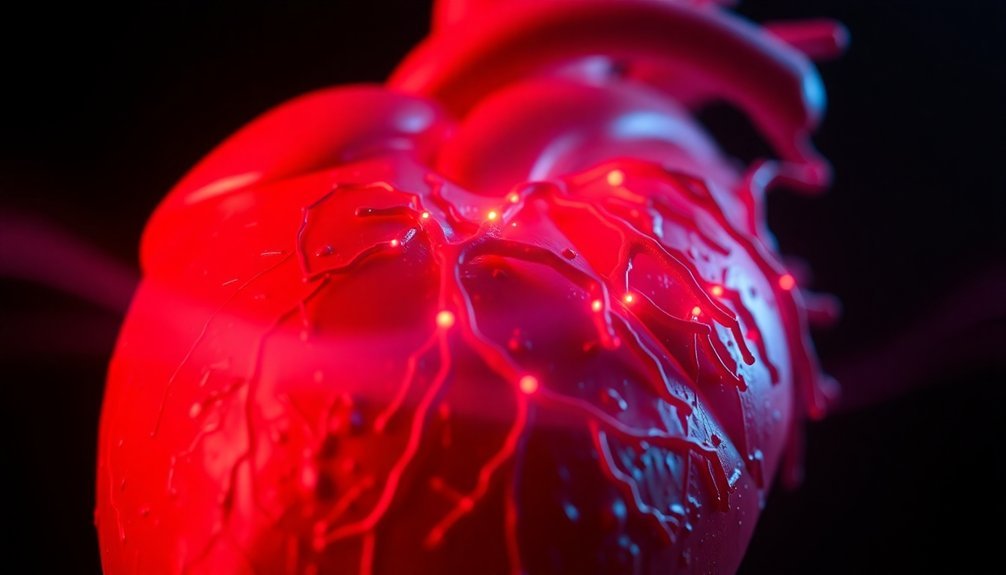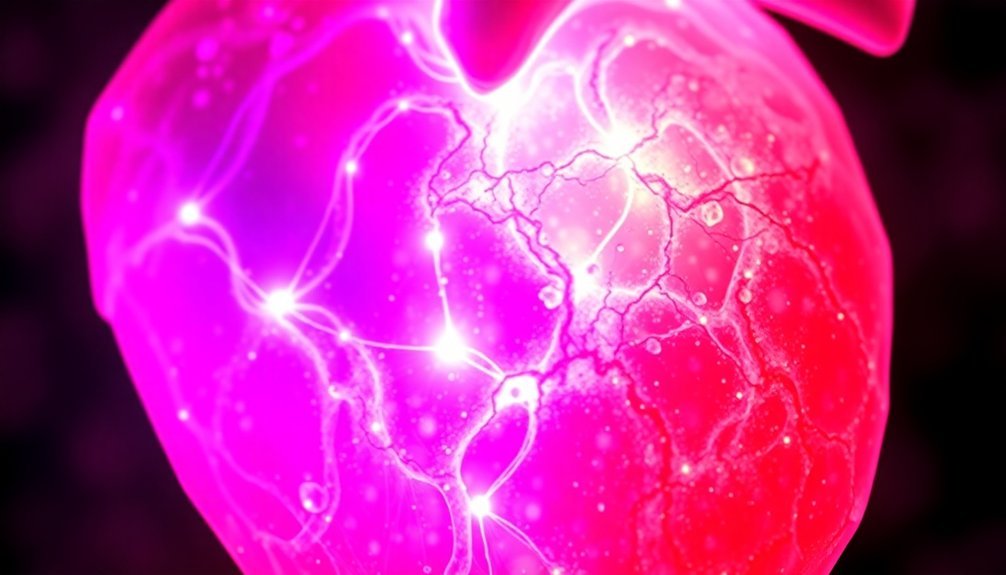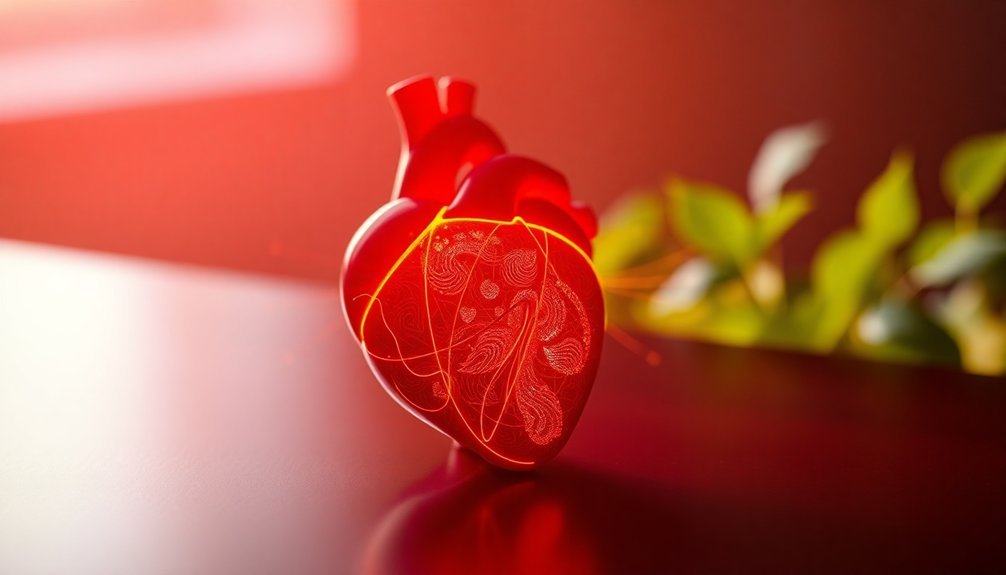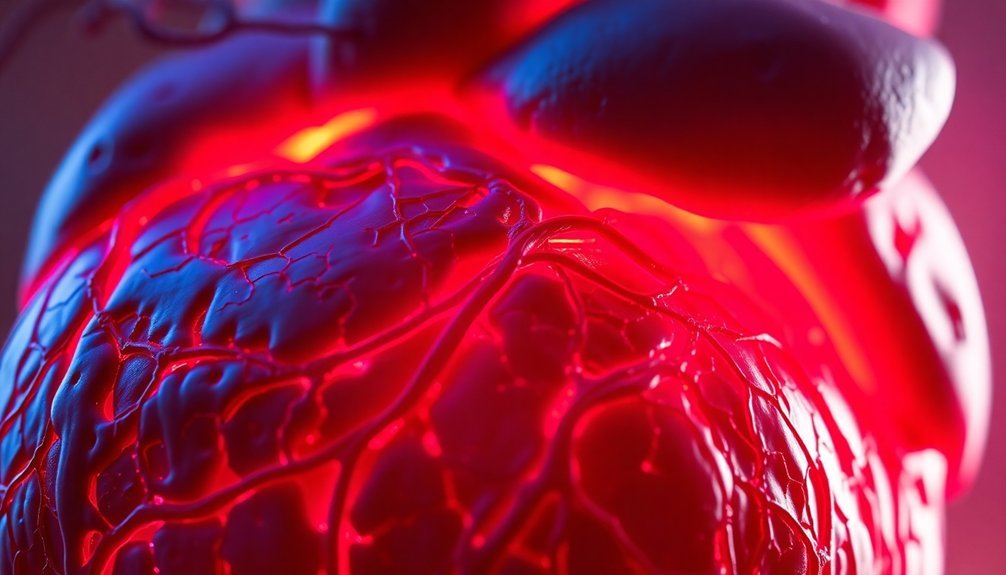Infrared waves can revive heart tissue in several powerful ways. They enhance blood circulation, increasing flow and preventing red blood cells from trapping in capillaries. This boost in circulation promotes tissue repair by ramping up energy production in cells. Also, infrared therapy reduces inflammation, balancing inflammatory mediators for better regeneration. It relieves muscle tension, allowing for relaxation and improved blood flow. Finally, it supports overall heart health, improving function and lowering risks associated with heart issues. These benefits can transform your well-being, and there's even more to uncover about how infrared waves work wonders.
Enhancing Blood Circulation

Enhancing blood circulation is essential for overall cardiovascular health, and infrared (IR) energy plays a significant role in this process. When you expose your body to IR energy, you'll notice a remarkable increase in blood flow velocity. In some models, postmortem blood flow velocity soars by about 300%.
Even under normal physiological conditions, you'll see a 30% rise in venous flow velocity, which is important for delivering oxygen and nutrients to your tissues. This increase in blood flow can occur due to the existence of a secondary driving mechanism, where blood vessels propel flow independently of the heart.
IR energy also prevents red blood cells from becoming trapped in capillaries, ensuring uninterrupted blood flow. When IR diminishes, capillaries fill up with erythrocytes, blocking circulation. Restoring IR energy allows capillary blood flow to resume, making circulation more effective.
Additionally, IR increases the diameter of arteries and veins, which enhances overall circulation. It even boosts vasomotor function, leading to improved microcirculation and reduced resistance in peripheral circulation.
This means your blood vessels can function more efficiently, enhancing oxygen delivery where it's needed the most. IR energy truly acts as a catalyst, optimizing your cardiovascular health by promoting better blood circulation.
Promoting Tissue Repair
Infrared therapy plays a pivotal role in promoting tissue repair, especially in heart tissue. It enhances mitochondrial function, boosting cellular energy production to support the growth and repair of damaged muscle cells. You'll find that increased ATP production speeds up tissue repair processes, allowing for the regeneration of compromised heart tissue. The therapy can mimic the effects of intense light therapy, which boosts the PER2 gene and protects heart tissue against low oxygen conditions.
The heating effects of infrared radiation penetrate deeply, reaching up to 5 millimeters beneath the skin. This not only stimulates local blood flow through vasodilation but also increases the temperature in deeper tissue layers, aiding in overall tissue healing. As molecules vibrate and produce heat, it creates a conducive environment for cellular activity.
Additionally, infrared therapy enhances neurological responses by increasing sensory nerve conduction velocity. This can lead to higher endorphin release, which helps manage pain and promotes tissue repair. Using infrared therapy before other treatments can improve tissue responsiveness, making recovery more effective.
Far-infrared therapy has shown evidence of inducing tissue repair in clinical settings and enhancing exercise performance.
Ultimately, by incorporating infrared therapy into rehabilitation regimens, you may greatly accelerate the repair and regeneration of heart tissue.
Reducing Inflammation

When it comes to reducing inflammation, infrared therapy offers a powerful approach that engages cellular mechanisms to promote healing. By triggering metabolic events at a cellular level, infrared light enhances the production of nitric oxide, which helps relax arteries and combat free radicals. This process elevates cellular energy, stimulating mitochondria to produce more adenosine triphosphate (ATP), ultimately improving cellular function and decreasing inflammation.
As you experience enhanced blood circulation from infrared therapy, essential nutrients and oxygen are delivered to damaged tissues, fostering regeneration. The therapy helps regulate inflammatory mediators, benefiting conditions like knee osteoarthritis and lower back pain. By reducing pro-inflammatory substances while increasing anti-inflammatory factors, infrared therapy balances the body's natural response to injury or infection. Additionally, many treatments targeting inflammation, such as pharmaceuticals, can come with risks that infrared therapy avoids.
The anti-inflammatory effects also extend to vascular health, as infrared therapy improves blood flow and purges inflammatory waste from affected tissues.
With clinical trials backing its efficacy, this non-invasive method serves as an effective alternative to traditional pain relief techniques. By embracing infrared therapy, you can facilitate healing and experience relief from inflammation, leading to a better quality of life.
Relieving Muscle Tension
Many people experience muscle tension that can hinder daily activities and overall well-being. Thankfully, infrared therapy offers an effective solution by penetrating inner skin layers up to 2-7 centimeters, reaching deep muscles and nerves.
When your cells absorb infrared light, it triggers crucial metabolic processes that enhance cellular activity. This boost in absorption helps relieve tension by improving blood circulation and nutrient delivery to your muscles.
As blood circulation increases, essential nutrients and oxygen flood your muscles, promoting relaxation and reducing stiffness. Enhanced blood flow also aids in relaxing arteries and prevents issues like platelet clumping.
Plus, infrared light stimulates sensory nerve conduction, which can alleviate pain and allow tight muscles to unwind. You'll even experience a spike in endorphins, your body's natural painkillers, which help diminish discomfort and muscle spasms.
Infrared therapy is commonly used in physiotherapy to address both acute and chronic muscle pain. Whether you use devices at home or receive treatment in clinical settings, sessions typically last between 14 to 25 minutes each.
Regular application can greatly reduce soreness, spasms, and stiffness, helping you enjoy a more active, pain-free life.
Supporting Overall Heart Health

After addressing muscle tension, it's crucial to contemplate how infrared therapy can also support overall heart health.
By incorporating waon therapy into your routine, you're not just easing muscle strain but also enhancing your vascular function. This type of infrared sauna therapy can improve the cells lining your arteries, boosting blood flow and lowering both systolic and diastolic blood pressure temporarily.
If you have chronic heart failure, waon therapy can elevate your cardiac function and exercise capacity, making day-to-day activities easier.
Studies indicate that regular sessions can considerably decrease the risks of hospitalization and mortality associated with severe heart issues.
Furthermore, if you're managing conditions like type 2 diabetes, you're likely to notice improvements in waist circumference and overall cardiovascular health.
Frequently Asked Questions
Can Infrared Therapy Be Used Alongside Other Heart Treatments?
Yes, you can definitely use infrared therapy alongside other heart treatments. It enhances cardiac function, reduces inflammation, and supports healing, making it a valuable complement to various therapeutic approaches for better heart health outcomes.
How Long Should Infrared Therapy Sessions Last for Heart Health?
For heart health, infrared therapy sessions should last about 15 minutes, ideally two times a week. This duration optimizes blood circulation and tissue repair while minimizing risks, making it effective for your treatment plan.
Are There Any Contraindications for Using Infrared Therapy on Heart Patients?
Yes, there are contraindications for heart patients using infrared therapy. Unstable heart conditions, low blood pressure, and arrhythmias can pose risks. Always consult your healthcare provider before starting infrared therapy to guarantee it's safe for you.
What Types of Infrared Devices Are Best for Heart Tissue Rejuvenation?
For heart tissue rejuvenation, consider using Near-Infrared (NIR) light therapy devices, Far-Infrared (FIR) systems, or LED light therapy units. These options effectively enhance blood circulation and stimulate cellular energy for improved healing and recovery.
Can Infrared Therapy Help With Heart-Related Anxiety or Stress?
Yes, infrared therapy can greatly help with heart-related anxiety or stress. It lowers cortisol, boosts serotonin, and promotes relaxation, effectively calming your mind and improving overall mental well-being after sessions. You'll likely feel the benefits.
In Summary
Incorporating infrared waves into your heart health routine can truly make a difference. By enhancing blood circulation, promoting tissue repair, reducing inflammation, relieving muscle tension, and supporting overall heart health, these waves offer a multifaceted approach to reviving your heart tissue. Embracing this technology could lead you to better cardiovascular well-being. So, why not explore the potential of infrared waves and take a proactive step towards a healthier heart? Your heart deserves it!





Leave a Reply